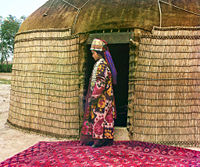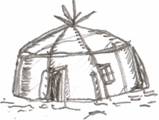Difference between revisions of "Yurt" - New World Encyclopedia
(→Use) |
|||
| Line 40: | Line 40: | ||
[[Image:Yourte mongole.JPG|thumb|Mongolian yurt. the sign says (roughly) "Food, Fast food restaurant, General store"]] | [[Image:Yourte mongole.JPG|thumb|Mongolian yurt. the sign says (roughly) "Food, Fast food restaurant, General store"]] | ||
[[Image:Mongol yurt.jpg|thumb|A yurt in south-mongolia, gobi. With Aruul (dried curds) on the roof.]] | [[Image:Mongol yurt.jpg|thumb|A yurt in south-mongolia, gobi. With Aruul (dried curds) on the roof.]] | ||
| − | For centuries, people throughout Central Asia used yurts as their homes. [[Humanitarian aid]] organizations provide yurts to families suffering from inadequate [[shelter]] due to extreme [[poverty]]. A ger protects a family in Mongolia from the cold temperatures and icy winds that whip across their barren homeland better than western-style rectangular shacks.<ref>World Vision [http://donate.worldvision.org/OA_HTML/xxwvibeCCtpItmDspRte.jsp?section=10058&item=126 Protection from exposure and cold]. ''Gift Catalog'', 2008. Retrieved November 17, 2008.</ref> | + | For centuries, people throughout Central Asia used yurts as their homes. They are cool in summer and with a stove are easily warmed in winter. [[Humanitarian aid]] organizations provide yurts to families suffering from inadequate [[shelter]] due to extreme [[poverty]]. A ger protects a family in Mongolia from the cold temperatures and icy winds that whip across their barren homeland better than western-style rectangular shacks.<ref>World Vision [http://donate.worldvision.org/OA_HTML/xxwvibeCCtpItmDspRte.jsp?section=10058&item=126 Protection from exposure and cold]. ''Gift Catalog'', 2008. Retrieved November 17, 2008.</ref> |
== Symbolism == | == Symbolism == | ||
Revision as of 23:07, 17 November 2008
A Yurt or Ger is a portable, felt-covered, wood lattice-framed dwelling structure used by nomads in the steppes of Central Asia.
Origin
The word Yurt is originally from the Turkic word meaning "dwelling place" in the sense of "homeland"; the term came to be used in reference to the physical tent-like structures only in other languages. In Russian the structure is called yurta (юрта), whence the word came into English.
In Kazakh (and Uyghur) the term for the structure is kiyiz üy (киіз үй, lit. "felt home"). In Kyrgyz the term is boz üý (боз үй), literally "grey house," because of the color of the felt. In Mongolian it is called a ger (гэр). Afghans call them "Kherga"/"Jirga" or "ooee." In Pakistan it is also known as gher (گھر). In Hindi, it is called ghar (घर).
The similarly structured Yaranga is a traditional mobile home of some nomadic Chukchi and Siberian Yupik in the Northern part of Russia. The word yaranga comes from the Chukchi language. In Russian use, the terms chum (a tent-like structure similar to Native American tipis used by Nenets people in Russia), Yurt, and Yaranga may be used indiscriminately.
Construction
Traditional yurts consist of a circular wooden frame carrying a felt cover. The felt is made from the wool of the flocks of sheep that accompany the pastoralists. The timber to make the external structure is not to be found on the treeless steppes, and must be traded for in the valleys below.
The frame consists of one or more lattice wall-sections, a door-frame, roof poles and a crown. Some styles of yurt have one or more columns to support the crown. The (self-supporting) wood frame is covered with pieces of felt. Depending on availability, the felt is additionally covered with canvas and/or sun-covers. The frame is held together with one or more ropes or ribbons. The structure is kept under compression by the weight of the covers, sometimes supplemented by a heavy weight hung from the center of the roof. They vary regionally, with straight or bent roof-poles, different sizes, and relative weight.
It is designed to be dismantled and the parts carried on camels or yaks to be rebuilt on another site.
Modern yurts are simple to construct with a few common wood-working tools. They are easy to erect and can be taken down in an hour.[1]
Use
For centuries, people throughout Central Asia used yurts as their homes. They are cool in summer and with a stove are easily warmed in winter. Humanitarian aid organizations provide yurts to families suffering from inadequate shelter due to extreme poverty. A ger protects a family in Mongolia from the cold temperatures and icy winds that whip across their barren homeland better than western-style rectangular shacks.[2]
Symbolism
- Coat of arms of Kazakhstan (flat).svg
Kazakh coat of arms
The wooden lattice crown of the yurt, the shangrak (Mongolian: тооно, toono; Kazakh: Шаңырақ, shangyraq; Kyrgyz: түндүк, tunduk) is itself emblematic in many Central Asian cultures. In old Kazakh communities, the yurt itself would often be repaired and rebuilt, but the shangrak would remain intact, passed from father to son upon the father's death. A family's length of heritage could be measured by the accumulation of stains on the shangrak from generations of smoke passing through it. A stylized version of the crown is in the center of the Coat of arms of Kazakhstan, and forms the main image on the flag of Kyrgyzstan.
Variations
The traditional yurt or ger continues to be commonly used in many parts of Central Asia and northern Europe. Additionally, enthusiasts in other countries have taken the visual idea of the yurt—a round, semi-permanent tent—and have adapted it to their cultural needs. Although those structures may be copied to some extent from the originals found in Central Asia, they have been greatly changed and adapted and are in most cases very different.
Yaranga
Yaranga is a tent-like traditional mobile home of some nomadic Northern indigenous peoples of Russia, such as Chukchi and Siberian Yupik. They are built of a light wooden frame, cone-shaped or rounded, and covered with reindeer hides sewn together.[3] A medium-size yaranga requires about 50 skins. A large yaranga is hard to heat completely in winter; there is a smaller cabin, a polog, built inside, that can be kept warm where people sleep.[4]
The Chapline Eskimos (Ungazigmit), Siberian Yupik peoples, also use yarangas for winter. They have a framework made of posts and covered with canvas.[5] The yaranga was surrounded by sod or planking at the lower part. There was a smaller cabin inside it at the backt, used for sleeping and living. It was separated from the outer, cooler parts of the yaranga with haired reindeer skins and grass, supported by a cage-like framework. The household work was done in the main section of the yaranga in front of this inner building, and many household utensils were kept there; during winter storms and at night the dogs were also kept there.<refРубцова 1954: 100–101</ref>
Western yurts

In the United States and Canada, yurts are made using modern materials. They are highly engineered and built for extreme weather conditions. In addition, erecting one can take days and they are not intended to be moved often. Often the designs of these North American yurts barely resemble the originals; they are better named yurt derivations, because they are no longer round felt homes that are easy to mount, dismount, and transport.
There are three North American variants, the portable fabric yurt, the tapered wall yurt, and the frame panel yurt.[6]
North American yurts and yurt derivations were pioneered by William Coperthwaite in the 1960s, after he was inspired to build them by an article about Supreme Court Justice William O. Douglas's visit to Mongolia.[7] The photographs of Mongolian gers inspired him and he began designing wooden yurts. Over the years he became involved in hundreds of educational and community projects involving the building of yurts. One of Coperthwaite's students David Raitt, also went on to pursue yurt design and building.[8]
In Europe, a closer approximation to the Mongolian and Central Asian yurt is in production in several countries. These tents use local hardwood, and often are adapted for a wetter climate with steeper roof profiles and waterproof canvas. In essence they are yurts, but some lack the felt cover that is present in traditional yurt.
Different groups and individuals use yurts for a variety of purposes, from full-time housing to school rooms, offices, shops, and studios. In some provincial parks in Canada, and state parks in several US states, permanent yurts are available for camping. Yurts have also been used to house migrant workers in Napa Valley, California.
Notes
- ↑ Paul King, 2002
- ↑ World Vision Protection from exposure and cold. Gift Catalog, 2008. Retrieved November 17, 2008.
- ↑ Countries and Their Cultures, Living Conditions World Cultures: Norway to Russia, 2007. Retrieved November 17, 2008.
- ↑ Vladimir Dinets, Chukchi art Vladimir Dinets website, 2006. Retrieved November 17, 2008.
- ↑ Рубцова 1954: 515
- ↑ Becky Kemery, 2006. Yurts: Living in the Round. Gibbs Smith, Publisher. ISBN 978-1586858919
- ↑ Becky Kemery, 2001, Yurts - Round and Unbound. Alternatives Magazine 18. Retrieved November 16, 2008.
- ↑ David Raitt, History. Vital Designs, 2006. Retrieved November 16, 2008.
ReferencesISBN links support NWE through referral fees
- Kemery, Becky. 2001. Yurts - Round and Unbound. Alternatives Magazine 18. Retrieved November 16, 2008.
- Kemery, Becky. 2006. Yurts: Living in the Round. Gibbs Smith, Publisher. ISBN 978-1586858919
- King, Paul. 2002. The Complete Yurt Handbook. Eco-Logic Books. ISBN 1899233083
- Kuehn, Dan Frank. 2006. Mongolian Cloud Houses: How to Make a Yurt and Live Comfortably. Shelter Publications. ISBN 978-0936070391
- Raitt, David. 2006. History. Vital Designs. Retrieved November 16, 2008.
- Рубцова (Rubcova), Е. С. 1954. Материалы по языку и фольклору эскимосов (чаплинский диалект) (Materials on the Language and Folklore of the Eskimos, Vol. I: Chaplino Dialect). Москва: Российская академия наук (Moscow: Russian Academy of Sciences).
External links
- Yurt FAQ
- yurtinfo.org A comprehensive resource for yurts and related structures
- Simply Differently.org Yurt building resources
- Build your own Yurt
- DEC n' NRT Build a YURT
- Kazakh Yurt Set-Up video from Kazakh community in northwestern China.
- Chukchi art
- Winter yaranga in Ungazik village
Credits
New World Encyclopedia writers and editors rewrote and completed the Wikipedia article in accordance with New World Encyclopedia standards. This article abides by terms of the Creative Commons CC-by-sa 3.0 License (CC-by-sa), which may be used and disseminated with proper attribution. Credit is due under the terms of this license that can reference both the New World Encyclopedia contributors and the selfless volunteer contributors of the Wikimedia Foundation. To cite this article click here for a list of acceptable citing formats.The history of earlier contributions by wikipedians is accessible to researchers here:
The history of this article since it was imported to New World Encyclopedia:
Note: Some restrictions may apply to use of individual images which are separately licensed.


















